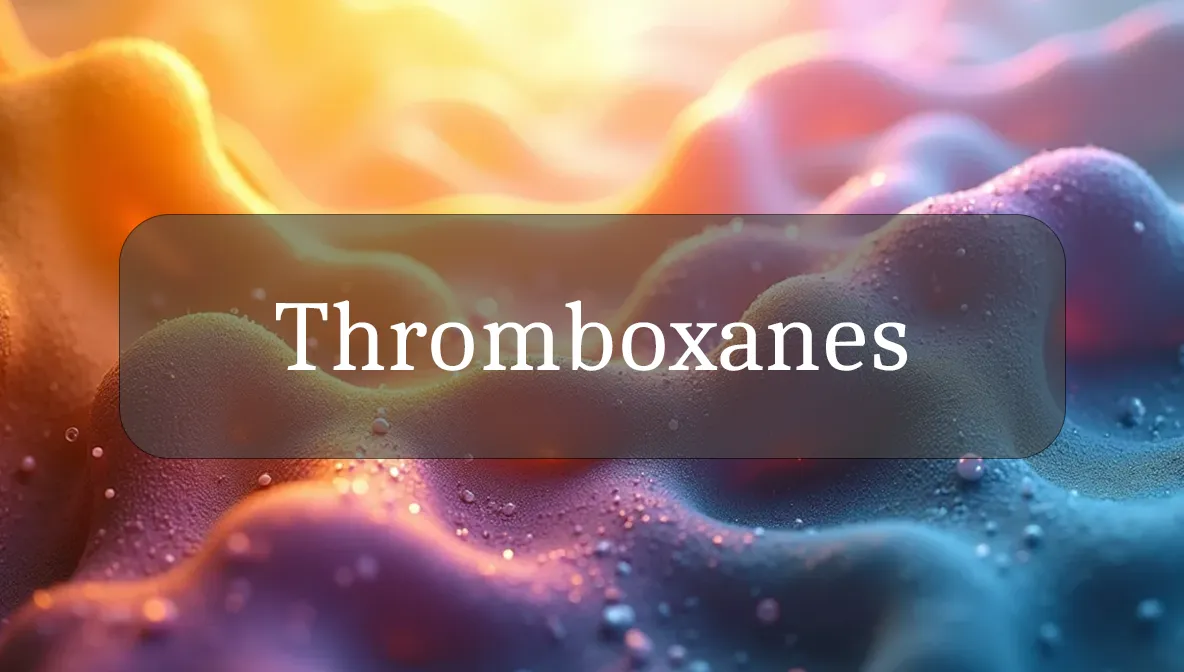Blood and Inflammation Regulators for Heart Health
Thromboxanes are like your body’s traffic cops for blood flow, tiny molecules that help control clotting and inflammation to keep your heart and vessels healthy. They’re key players in daily wellness, balancing healing and circulation, but can contribute to issues when out of whack. Let’s explore what thromboxanes are, how they benefit your health, and practical ways to support their balance—all in a clear, friendly way to empower your wellness journey.
Chemical Identity and Type
Thromboxanes are lipid-based molecules in the eicosanoid family, derived from arachidonic acid, a fatty acid in cell membranes. They’re produced on demand by cells like platelets and immune cells through the cyclooxygenase (COX) enzyme pathway. Thromboxanes act as body signals, binding to specific receptors to promote blood clotting and blood vessel constriction. They’re not stored but made as needed, often during injury or inflammation, and their levels depend on diet and lifestyle.
Biological Role and Benefits
Thromboxanes are your body’s guardians of blood flow and healing, playing critical roles in wellness. Here’s how they support you:
- Blood Clotting: Thromboxanes help platelets stick together, forming clots to stop bleeding from cuts or injuries.
- Vascular Health: They constrict blood vessels to regulate blood flow, supporting stable blood pressure during stress or injury.
- Inflammation Support: Thromboxanes trigger short-term inflammation to fight infections or promote healing at injury sites.
- Heart Protection: By aiding clotting, they prevent excessive bleeding, protecting your cardiovascular system.
- Wound Healing: They guide immune cells to injuries, speeding up tissue repair.
When balanced, thromboxanes boost your recovery, circulation, and overall vitality.
Dietary or Natural Sources
Your body makes thromboxanes from arachidonic acid, found in omega-6 fatty acids in your diet. Key sources include:
- Animal-Based: Beef, chicken, eggs, and fish (rich in arachidonic acid).
- Dairy: Milk, yogurt, and cheese.
- Plant-Based: Soybeans, peanuts, and vegetable oils (e.g., corn, sunflower).
- Nutrient Boosters: Omega-3 fatty acids (salmon, flaxseeds), vitamin C (oranges, bell peppers), zinc (nuts, oysters), and antioxidants (berries, turmeric) help balance thromboxane production by reducing excessive inflammation.
- Anti-Inflammatory Foods: Ginger, garlic, and green tea may calm overactive thromboxane effects.
No thromboxane supplements exist, as they’re made in the body. Omega-3 supplements (1–2 grams daily) or antioxidant supplements (e.g., vitamin C, 500–1,000 mg daily) can help regulate thromboxane activity. Aim for a balanced omega-6 to omega-3 ratio (4:1 or lower) to prevent excess clotting or inflammation.
Signs of Imbalance or Dysfunction
Thromboxane imbalance, often from overproduction, can lead to excessive clotting or inflammation. Signs include:
- Excess Thromboxanes:
- Increased clotting risk, potentially leading to heart attack or stroke.
- High blood pressure from excessive blood vessel constriction.
- Chronic inflammation, causing joint pain or swelling (e.g., in arthritis).
- Chest pain or shortness of breath in severe cases.
- Low Thromboxanes (Rare):
- Slow clotting, leading to excessive bleeding or bruising.
- Delayed wound healing from reduced platelet activity.
Overproduction may stem from high omega-6 intake, stress, or conditions like heart disease or diabetes. Underproduction is rare but can occur with low fat intake or certain medications.
Supporting Optimal Levels or Function
To keep thromboxanes balanced and maintain their benefits, try these practical steps:
- Eat Balanced Fats: Include omega-3-rich foods (salmon, chia seeds) and limit omega-6-heavy oils (corn, soy) to moderate thromboxane production.
- Boost Anti-Inflammatory Nutrients: Eat vitamin C (berries, peppers), zinc (seeds, oysters), and antioxidants (turmeric, blueberries) to reduce excess inflammation.
- Stay Active: Moderate exercise like walking or swimming (3–5 times weekly) supports heart health and balanced clotting.
- Get Enough Sleep: Aim for 7–9 hours to regulate inflammation and stress-driven thromboxane activity.
- Manage Stress: Chronic stress can boost thromboxane production; try meditation, deep breathing, or yoga.
- Stay Hydrated: Drink 8–10 cups of water daily to support circulation and overall health.
- Consider Supplements: Omega-3s (1–2 grams daily) or curcumin (500 mg daily) may help balance thromboxane effects.
Safety, Interactions, and Precautions
Thromboxanes are naturally produced and safe when balanced, but consider these points:
- Heart Risks: Overactive thromboxanes can increase clotting risks, contributing to heart attack or stroke, especially in those with heart disease.
- Medications: Aspirin or NSAIDs block thromboxane production to reduce clotting; consult your doctor if on blood thinners or anti-inflammatory drugs.
- Supplements: Omega-3s or antioxidants are safe but may cause mild digestive upset in high doses (e.g., above 3 grams for omega-3s).
- Allergies: Fish-based omega-3 supplements may trigger reactions in sensitive individuals.
- Chronic Conditions: Diseases like diabetes or atherosclerosis involve thromboxanes and need medical management.
Prioritize a heart-healthy diet and lifestyle to naturally regulate thromboxane activity.
Fun Fact
Did you know thromboxanes were named because they were first found in thrombocytes (platelets)? These tiny molecules are like your blood’s emergency responders, jumping into action to stop bleeding in a split second!
Citations
- National Institutes of Health. (2023). Eicosanoids and cardiovascular health. MedlinePlus.
- Mayo Clinic. (2024). Nutrition for heart and vascular health.
- Cleveland Clinic. (2022). The role of thromboxanes in clotting and inflammation.
- World Health Organization. (2020). Nutrient requirements for cardiovascular health.
- American Heart Association. (2023). Thrombosis and eicosanoid pathways.

